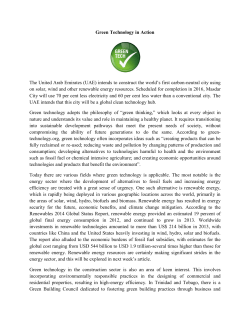
EV Zero Emissions Driving For Electric Vehicles
Zero Emissions Driving For Electric Vehicles Zero emissions driving of Electric Vehicles (EVs) requires renewable energy for charging via one of the following options: Each option must deal with issues such as EV charging time and location relating to renewable energy production, cost and convenience. • On-site renewable energy generation This means charging should be undertaken using outlets which are known to use renewable energy. In instances where this isn’t possible or certain, charging should be monitored and accounted for as part of the overall renewable energy strategy. • GreenPower or Renewable Energy Certificate (REC) purchase • Charging service agreements To learn more about measuring and managing your EV charging, refer to the supporting information below. Renewable electricity supply option On-site renewable energy generation Advantages Disadvantages More information • Takes advantage of existing renewable energy supply • Confusing in prospect • Upfront cost if no system already in place • Clean Energy Council solar PV accreditation www. solaraccreditation.com.au/ • More obvious link to renewable energy supply • Measurement and accounting required to reconcile EV charging with renewable energy production • Alternative Technology Association www.ata.org.au • Need to cater for off-site charging • Clean Energy Regulator http:// ret.cleanenergyregulator.gov.au/ • May prove more costly than GreenPower or REC purchase GreenPower or Renewable Energy Certificate (REC) purchase Charging service agreement • No upfront costs • Ongoing costs • Your electricity retailer • Simple • GreenPower may struggle with off-site charging • GreenPower program www.greenpower.gov.au • REC purchase a burden and may be complicated • REC trading companies • Most reliable way of linking EV charging to renewable energy use • REC purchase accommodates off-site charging • Measurement and accounting required if only a percentage of the bill is GreenPower or to reconcile with RECs • Likely to support off-site charging • Need to account for charging using outlets not operated by your contracted provider • Simple • Good information and charge management capabilities www.transport.vic.gov.au/evtrials • Ongoing costs • Upfront cost for a dedicated charging unit (if so desired) Electric vehicle charging service providers Measuring EV energy use On-site Renewable Energy Generation Vehicle energy efficiency is influenced by a range of factors including driving style, use of accessories (particularly heating and cooling), traffic conditions, and the amount of passengers and luggage. Using renewable energy generated on site is an obvious but complicated zero emissions charging option. For this reason charging energy should be measured instead of calculated on manufacturer’s figures. This can be done a number of ways, including via: For owners of “grid-connected” renewable energy systems installed before 2011, the renewable energy generated by their system is accounted for through RECs. In this case, for the operator to claim the energy used as being renewable they must: • Vehicle data – if equipped with this capability, noting that many are not • Ensure that the amount of energy produced by the system will satisfy their EV charging needs, and • Electric Vehicle Supply Equipment (EVSE) – dedicated charging units which may cost between $500 and $4000, provide a range of features including enhanced safety, improved charging times, remote energy management and monitoring, and will generally need to be installed by a licensed electrician • Voluntarily surrender the corresponding amount of RECs (rather than sell or trade them) or avoid creating RECs in the first place. • Electricity consumption monitor – a simple device which may cost around $100, be possible for the homeowner to install, and provides basic information which may need to be manually checked Additional options in terms of home energy management may also be available via your energy retailer and ultimately the ‘smart meter’ that is being installed in all Victorian homes. For owners of small-scale systems (such as rooftop solar cells) that were installed any time from 2011 onwards, the new form of REC called a Small-scale Technology Certificate (STC) is accounted for in a way that means the owner retains renewable energy created. In this instance, the operator may claim their charging energy to be renewable if the average energy generated by their system is equal to or greater than the average energy used for charging. For owners of large-scale systems that were installed any time from 2011 onwards, the market works as for the pre-2011 systems however the RECs are now known as Large-scale Generation Certificates (LGCs). For systems which are not grid-connected or covered by RECs, it is possible to charge using renewable energy. For charging outside of times when sufficient energy is being produced, energy will need to be drawn from a storage facility such as a battery bank (a role normally played by the grid). A typical EV charging arrangement for a household with renewable energy supply. Charging energy may be measured via one or more of the EV, EVSE or the electricity consumption monitor. Solar photovoltaic system Electric Vehicle (EV) www.transport.vic.gov.au/evtrials Grid connection EV Supply Equipment (EVSE) or Electricity consumption monitor GreenPower or Renewable Energy Certificate (REC) Purchase Charging Service Agreements GreenPower is a means of purchasing renewable energy through your electricity retailer. There is no upfront cost, and the ongoing costs as of November 2012 for 100 per cent GreenPower are around 5c per kWh on top of the standard electricity tariff. This translates to around $1 extra for a full EV battery charge. GreenPower is often purchased as a percentage of your overall electricity bill. By measuring EV energy use and ensuring this is covered by the amount of GreenPower purchased, the costs of your renewable energy charging strategy can be minimised. The GreenPower program is based upon a trading market for Renewable Energy Certificates (RECs). RECs are issued to renewable energy generators for each unit of accredited energy they produce. To ensure the environmental benefits, only renewable energy projects that meet strict environmental standards receive accreditation. GreenPower or RECs may also be bought separately to your actual electricity usage from your retailer or a trader. This approach has the advantage of supporting charging away from your home address should it use non-renewable electricity. Careful accounting is required to ensure your GreenPower or REC purchases cover all your charging needs. Specialist EV charging service providers are new businesses that have emerged to cater for the needs of EV operators. These companies offer dedicated EV charging technology installation and operation, enhanced energy management and safety, data provision, public charging network access, and most pertinently to this guidance – renewable energy supply arrangements. For EV charging service providers who have committed to renewable energy supply, drivers may utilise their network to charge in a variety of locations and be confident that they’re using renewable energy. This is usually accessed through a membership or subscription arrangement, although pay-per-use options may also be available. Variations in the electricity supply arrangements from one location to the next may require individual charging outlets to be confirmed as being supplied with renewable energy – as with all things it pays to check the fine print. The GreenPower renewable energy purchasing program $ You buy a percentage of GreenPower Audits Greenpower provider its ed Renewable energy www.transport.vic.gov.au/evtrials Authorised by the Victorian Government, 121 Exhibition St, Melbourne Victoria 3000 Impact DOT7377/12 $ Increase in renewable energy Cr $ Invested in renewable energy Government Accredited
© Copyright 2025









